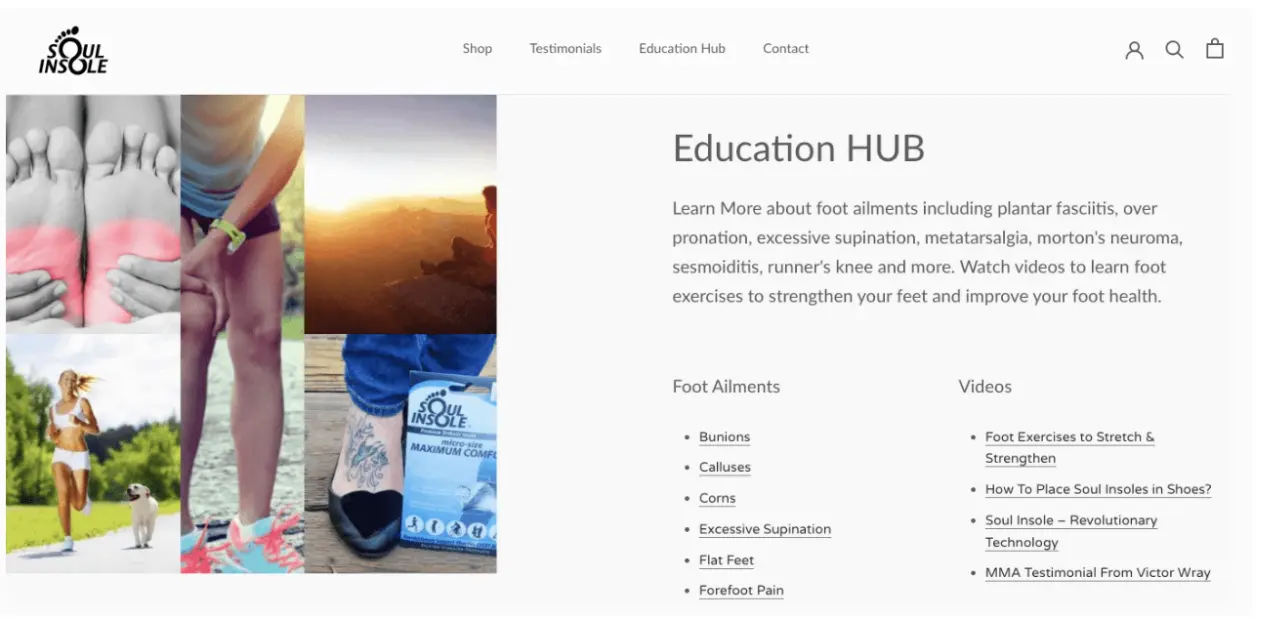“Marketing is telling the world you’re a rock star. Content Marketing is showing the world you are one.” – Robert Rose.
*Updated 7/11/2024
As an eCommerce business, it's not hard for you to compete with more prominent players and marketplaces. You must carve a unique brand positioning and create great content that attracts staunch fans and followers.
Doing it consistently and using content marketing to tell a story can help you boost eCommerce sales many times over.
8 Helpful eCommerce Content Strategies and Examples
Ready? Let's go.
1. Focus on audience pain points
You must remember that people are least interested in what you're selling unless you call them over for a free cup of coffee. But it isn’t feasible to invite your thousands of eCommerce prospects for a complimentary beverage. So why not help them in some way?
Content marketing allows eCommerce business owners to generate audience interest by offering them help. For instance, providing content that solves common skin-related problems makes sense if you sell skin-care products.
- It’s best to incorporate a problem-solving approach to eCommerce content marketing. The ideal way to start is to do keyword research and understand some key audience challenges.
- The next step is to create your ideal customers’ personas and document their challenges, interests, and preferences.
- Then, make sure you create user-intent-focused content.
Take a look at this example from Blume, a famous self-care brand:
Creating valuable content helps you rank your website on search engines, earn organic traffic, and generate awareness about your brand.
2. Build an eCommerce content hub
What if you could go one step ahead and offer everything around a specific topic in a single place?
The great news is that you can build a content hub where you can publish blog posts, videos, checklists, social media content, and even host podcasts.
- Create a series of how-to articles and guides that delight your target customers.
- Publish short DIY videos and get followers to share your content on social media platforms.
- Buying guides are a terrific addition to your content hub. Such content pieces help the audience to make a wise purchase decision.
Here’s an excellent example of a content hub from Soul Insole, a well-known foot care brand.
The education hub offers website visitors everything they need to know about foot ailments, including blog posts, videos, and FAQs. Using POWR’s free media gallery app, you can quickly put different content formats in a block-style gallery with customizable fonts, layouts, and sizing.
With a content hub, you can set yourself up for success by building topical authority that converts into precious organic traffic.
3. Publish interactive content
Wouldn't it be fun to visit a cafe that allows guests to brew a cup themselves? Similarly, content marketing works better when you make it a playful experience.
According to a study by Content Marketing Institute, 81% agree that interactive content grabs the audience's attention more effectively than static content.
- For example, you can post social media contests, polls, and quizzes that help your audience learn about the different products you sell. And you can offer an attractive prize to those who participate and win.
- Giveaways are great for incentivizing potential customers to start interacting with your brand and generate leads for your business.
Look at this offer from Airmid Beauty Secrets, a personal care brand that produces natural products for hair and skin.
4. Decode your products with a glossary
Some product-related words and phrases can be difficult to understand. It may lead your customers to pull out their hair in confusion. Don't worry; creating an eCommerce glossary page helps you kill two birds with one stone.
- First, you can create a dedicated section to demystify these terms and make it easy for your customers.
- Secondly, you can use such content pages to attract valuable search traffic to your website.
Here’s a superb example of a fashion glossary page from Zalora, a clothing e-retailer.
Source: Zalora
5. Showcase product-centric content
Promoting your eCommerce business is about getting those conversions rolling. So how do you do it?Product-related content is a great way to convert decision-stage buyers—people who’re ready to buy but still researching.
- Create content that shows how your products have many exciting features. Then, experiment with DIY content to display the different ways customers can use those products.
- Build an FAQ section to answer your prospects’ commonly asked questions. Take a look at this example:
- Yet another terrific strategy is to publish content that gives your readers helpful tips on product maintenance.
- Create a visual that includes your products for more complicated product offerings, like this biotech SEO resource.
6. Keep tabs on the latest trends
Niche-specific and trending content is a sure-shot winner. For instance, publishing blog posts and videos about upcoming and seasonal clothing trends is ideal if you're running an online fashion store.
In such a situation, you need to focus on offering cool ideas on how your audience can look their best.
- Follow niche news websites to know what’s hot in your industry.
- Use Google Trends to discover topics that may interest your target audience.
- Keep an eye on content that does well on social media like Facebook, Instagram, and YouTube.
- Keep tabs on competitive content to learn what’s working for them.
- Remember that every season and occasion allows you to produce audience-centric and engaging content.
Here’s an excellent example of a Friendship Day post from Proflowers, an online flower delivery service.
7. Differentiate your content from the competition
Imagine yourself as a prospective customer who can read blog posts and newsletters from five online shops selling similar eCommerce shop owners. Why would your ideal customer choose your content over others? Make an effort to be unique.
Try to tell stories that other eCommerce shop owners aren’t telling. For instance, you can decide to entertain your audience with a dash of humor and some dose of fun. Here’s a good example:
Creating and maintaining a unique content tone strengthens brand recall and helps improve your content conversion rate.
8. Publish social media content
Here is the thing. Successful eCommerce content marketing is about going social.
Social media is where most of the action takes place. Instagram is one platform where content creators post Instagram Reels and Stories by the dozen. Also, many of these videos get pretty decent traction as well.
- As an eCommerce marketer, you can use social media platforms to publish helpful and entertaining snackable content for your followers.
- You must also promote your website content on these essential online marketing platforms.
- Lastly, you can collaborate with social media influencers to discuss or review products in their upcoming content pieces.
Here’s an excellent example of influencer collaboration by Debenhams:
Final Thoughts
ECommerce content marketing is about offering your audience content that they can enjoy. You need to hook prospects with exciting stories and get them to engage with your branded content.
Work on creating value-driven infotainment that solves problems and builds a deeper emotional connection with prospective customers.
Author Bio
Abhishek Talreja is a seasoned international ghostwriter, content strategist, and columnist. Abhishek has been published on MarketingProfs, AllBusiness, Techinasia, Sitepoint, and more. He is the founder of Prolific Content Marketing.





